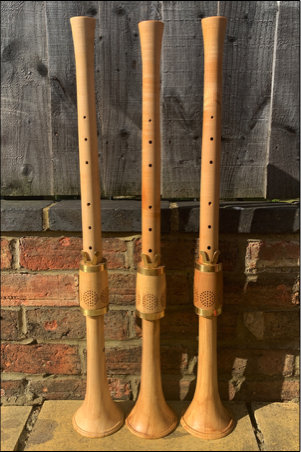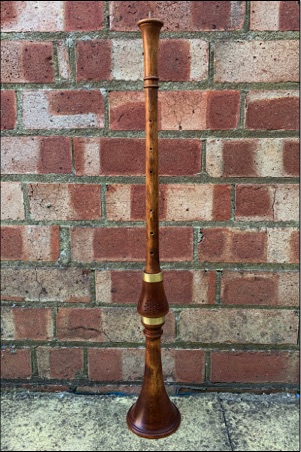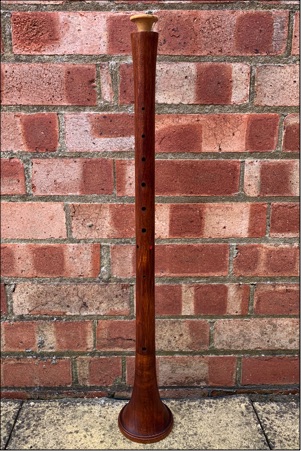Sopranino in F
An instrument of my own design with a small bore for a light sound to blend with the shawm band and other instruments.
Made from sycamore. A=440 or 466
£500
Soprano in D
Scaled from the instruments marked 'Melchor' in the MIM Brussels. A very stable instrument with a versatile dynamic range.
Made from stained sycamore. A=440 or 466
£650
Transitional Soprano in C
As Praetorius suggests, a shawm in C is a desirable and useful instrument. This instrument is designed to bridge the gap between the renaissance shawms in D and the Deutsche schalmei in C. It keeps the look of the renaissance instruments but has the bore profile of later instruments. Its shorter length helps reduce the weight and balance issues of the long renaissance style soprano in C. It’s best suited to music around the 1590's but can be used for later and earlier periods, with or without a pirouette.
Made from sycamore. A=440 or 466
£650
Alto Shawm / Pommer / Bombard in G
A scaled version of instrument 2326 in the Brussels collection. I keep the weight as close to the original as possible, around 500g. It plays with an 'unforked' C but I can make it 'forked' if desired.
Made from sycamore. A=440 or 465.
£1250
Niccolo Tenor in C
Based on the tenor in the Brussels collection.
Made from sycamore. A=440 or 465.
£1550
Extras:
Brass garland on bell - £100
Extra keys - £150 each


G Alto & Niccolo Tenor Shawms

Transitional Shawm in C
Deutsche Schalmei R. Haka
G Alto Shawms
Shawm Keywork
Soprano Shawm in D
Deutsche Schalmei - R. Haka
A copy of the instruments in the Rijksmuseum, Amsterdam made by Richard Haka. The schalmei were in use from about 1670 - 1720 in the Low Countries, Germany & England. They existed alongside the shawm and the baroque oboe. The sound is closer to the baroque oboe rather than the shawm. Talbot describes it as 'sweeter than Hautbois'.
It has a fontanelle but no key for the low C. It works well with either a fan shaped reed or a baroque oboe reed.
I also offer this instrument with a key which makes this a much more versatile instrument for the modern performer.
Made from fruitwood or hornbeam. A=415
Copy of the original: £750
With key: £900
Transitional Instruments

Quint Cromorne / Baroque Baritone Oboe
Quint Cromorne or Baroque Baritone Oboe:
Based on descriptions, engravings and carvings in Versailles, this instrument is 1 octave below the baroque oboe. This instrument fills in the gap between the alto or taille and the bassoon in early French repertoire. Perfect for Philidor!
It plays over two octaves with standard fingerings and it can be made with a choice of two bells, a 'baroque oboe' style after carvings (pictured) or with a 'shawm' style bell after engravings.
I offer this in two configurations due to the large stretch between the holes,
With 2 keys (C & Eb) £1600
With 6 keys (C, D, Eb, F, G, B) £2200
Made from stained maple. A=415

